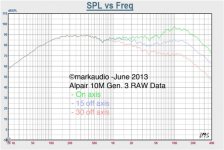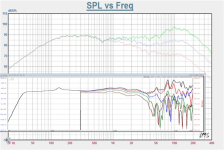Thanks! Quite a drastic difference to the manufacturer data. How was this measured?

looks pretty much the same for me, it's just no where near as smoothed.
No, it is not dramatically different from Mark's traces. Mine are on a 50dB scale while Marks's are on a 120dB scale. Mine were taken in a highly reverberate garage, Marks' we retaken in an anechoic chamber. My trace below 250Hz is a combined near-field, Mark's looks OB. My measurements were taken with Smith & Larson Woofer Tester Pro, Mark's were taken with LMS.
And finally.... My measurements are for the A10.2, Mark's measurements are for the A10.3.
This topic has been beaten to death on this forum. The A10.3 is a very fine driver, and it is the driver in my HT septup.
Bob
And finally.... My measurements are for the A10.2, Mark's measurements are for the A10.3.
This topic has been beaten to death on this forum. The A10.3 is a very fine driver, and it is the driver in my HT septup.
Bob
No, it is not dramatically different from Mark's traces. Mine are on a 50dB scale while Marks's are on a 120dB scale. Mine were taken in a highly reverberate garage, Marks' we retaken in an anechoic chamber. My trace below 250Hz is a combined near-field, Mark's looks OB. My measurements were taken with Smith & Larson Woofer Tester Pro, Mark's were taken with LMS.
And finally.... My measurements are for the A10.2, Mark's measurements are for the A10.3.
This topic has been beaten to death on this forum. The A10.3 is a very fine driver, and it is the driver in my HT septup.
Bob
Thanks. That explains some differences. Is your data gated? Do you still have the original measurement data?
You are comparing different drivers in different environments. The results are going to be different. End of discussion.
It is unfortunate that I have to publish measurements at all. Somehow people seem to think that they can hear subtle differences by looking at an FR plot. I will guarantee this: Any future FR plots that appear on my web site will be on a 100dB scale. That's industry standard anyway.
Bob
It is unfortunate that I have to publish measurements at all. Somehow people seem to think that they can hear subtle differences by looking at an FR plot. I will guarantee this: Any future FR plots that appear on my web site will be on a 100dB scale. That's industry standard anyway.
Bob
You are comparing different drivers in different environments. The results are going to be different. End of discussion.
It is unfortunate that I have to publish measurements at all. Somehow people seem to think that they can hear subtle differences by looking at an FR plot. I will guarantee this: Any future FR plots that appear on my web site will be on a 100dB scale. That's industry standard anyway.
Bob
I do agree that in-room steady-state magnitude-only response graphs don't correlate well with what we hear.
I'm more interested in how the driver itself performs. In this regard free field measurements are essential hence my initial question.
Last edited:
Understand. But uncontaminated free field measurements are extremely hard to do at the DIY level. Lacking a real anechoic chamber, the best that you can do is some sort of scaffolding the places the driver and mic at least 16' off of the ground. Or rent a cherry-picker. Otherwise, any measurements you come across are at best anecdotal. Consider my measurements to be anecdotal.
In the long run, you have two choices: Buy a pair of drivers. Filter through listening impressions posted here and elsewhere.
Bob
In the long run, you have two choices: Buy a pair of drivers. Filter through listening impressions posted here and elsewhere.
Bob
Bob, I must say I admire the patience and grace with which you repeated address this issue - if pressured for a response to such questions, it would be something along the lines of "just listen to the fracking things in your fracking system- they'll either work for you or not"
now, let's talk about something we know is important - what kind of wire should I use?
now, let's talk about something we know is important - what kind of wire should I use?
But spekr, it's not the same driver!!!!! What I posted is for the A10.2 . You have the A10.3!!!! My measurements will be useless to you.
Bob
Understand. Would be interested in the data anyway.
Bob, I must say I admire the patience and grace with which you repeated address this issue - if pressured for a response to such questions, it would be something along the lines of "just listen to the fracking things in your fracking system- they'll either work for you or not"
now, let's talk about something we know is important - what kind of wire should I use?
Well, I didn't ask for listening experiences but for measurements. Not sure what wires have to do with it.
As am I not sure about how comparing / examining measurement of two entirely different models, under entirely different conditions with different equipment, and displayed on different scales as Bob pointed out, could definitively answer your question, which is ultimately, what, exactly?
What kind of wires to use? Obviously, nothing less than the double-helix time-aligned, pressure-sensitive, wife-accepted, super-silicon-aggregated, perfectly matched and balanced imported Polish copper cadmium zinc ferrite oxide, AES and THX certified. 
No offense to genes, time, pressure, wives, silicon, Poland, AES, or THX. Or anyone else for that matter.
No offense to genes, time, pressure, wives, silicon, Poland, AES, or THX. Or anyone else for that matter.
Bob, I must say I admire the patience and grace with which you repeated address this issue - if pressured for a response to such questions, it would be something along the lines of "just listen to the fracking things in your fracking system- they'll either work for you or not"
now, let's talk about something we know is important - what kind of wire should I use?
- Status
- This old topic is closed. If you want to reopen this topic, contact a moderator using the "Report Post" button.
- Home
- Loudspeakers
- Full Range
- Alpair 10M Gen. 3 on/off axis measurements

